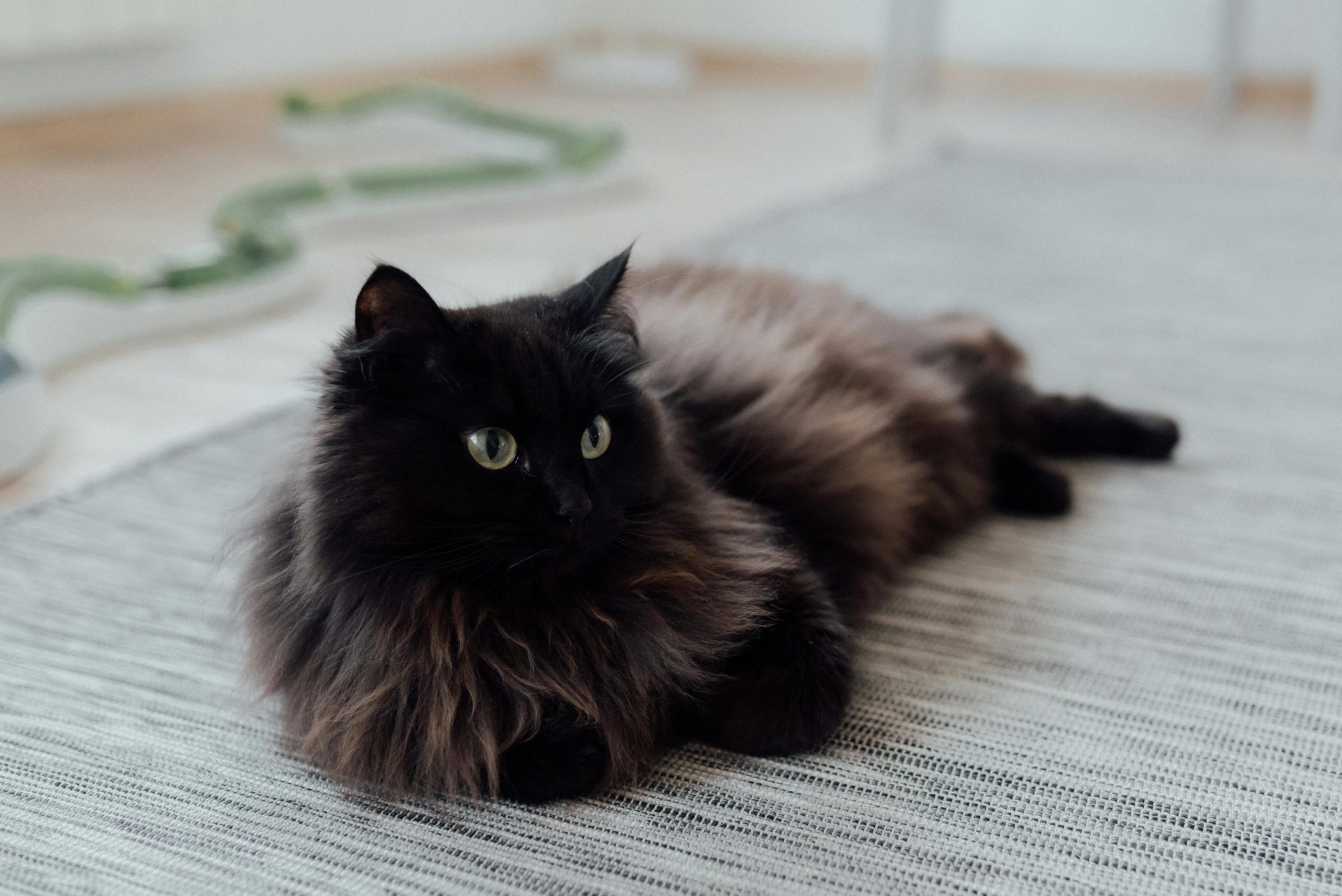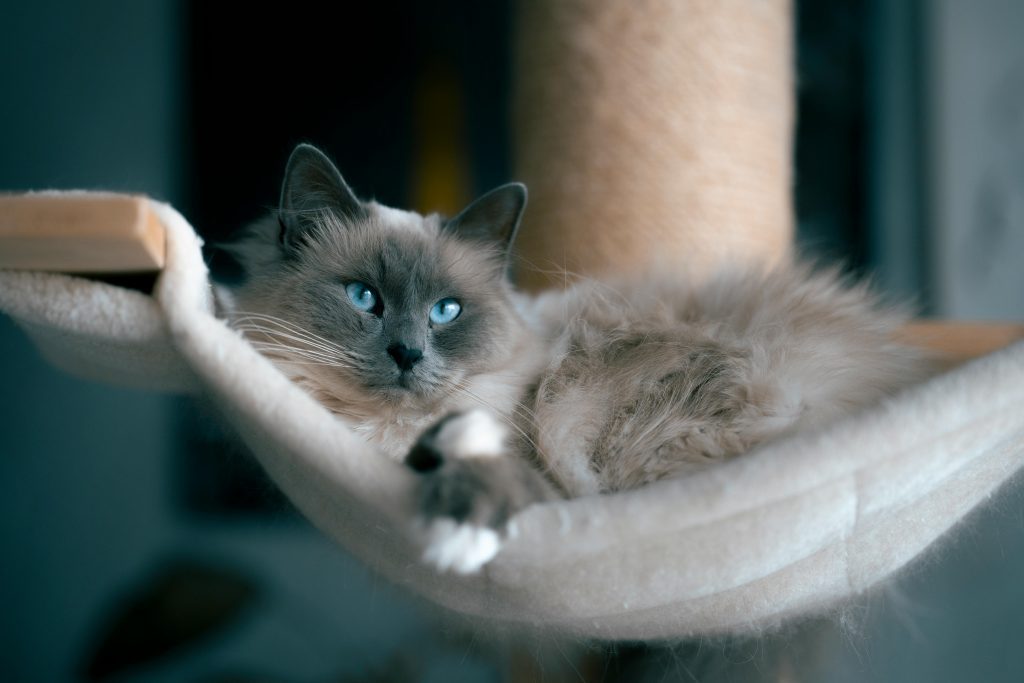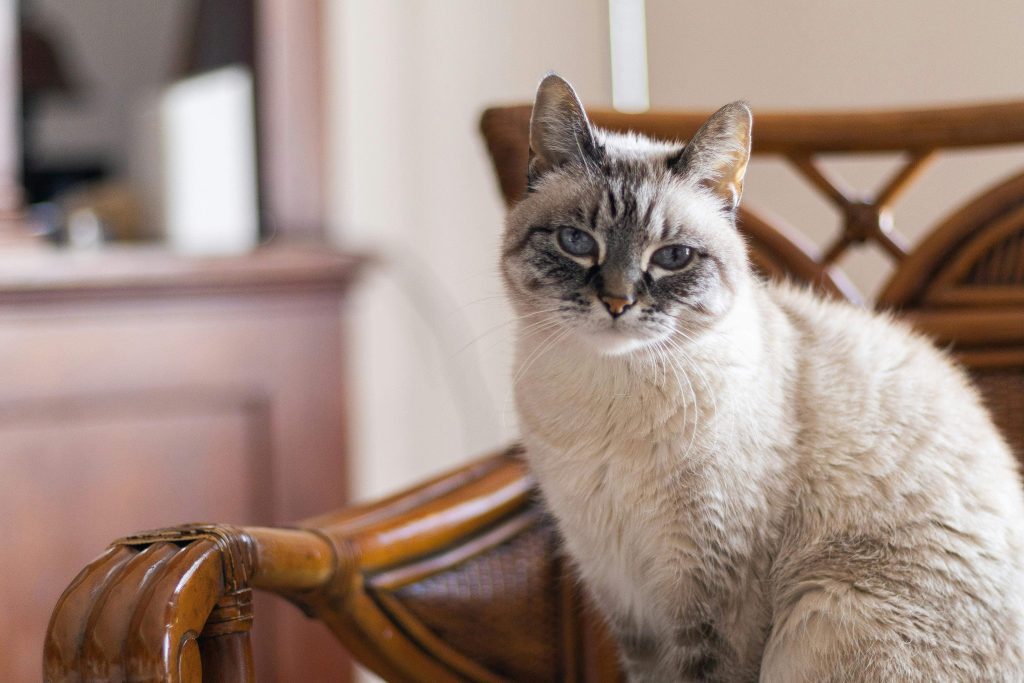At first glance, you might think that silky, jet-black cat can’t possibly be a Ragdoll — but you’d be wrong. While traditional Ragdolls are known for pointed colors like seal, blue, and chocolate, solid-colored Ragdolls — including black — do exist.
They may not match the classic look, but many still carry the true Ragdoll traits: large size, silky coat, and a famously docile temperament.
This often-overlooked fact sparks plenty of debate among breeders and fans. So if you’ve spotted a fluffy black cat with that unmistakable Ragdoll charm, you’re not imagining things. By the end of this guide, you’ll know exactly what sets them apart — and why they’re so captivating.
History and Genetics
To understand why black Ragdolls are a topic of debate, we have to go back to the 1960s, when breeder Ann Baker in California developed a line of laid-back, floppy cats starting with Josephine, a striking white long-haired feline with an easygoing nature. Baker’s early Ragdolls were selectively bred for their docile temperament and pointed coat colors like seal, blue, and chocolate.
Here’s the twist: black Ragdolls don’t carry the classic pointed pattern because they lack two recessive colorpoint genes. Yet they can still be 100% Ragdoll by lineage.
And as feline geneticist Dr. Lyons (UC Davis) puts it, “Genetics don’t lie—coat color doesn’t cancel out breed identity.”
So if your Ragdoll happens to be black, they’re no less genuine — they simply wear a different look from the traditional standard.
Can Ragdoll Cats Be Black?

Here’s the tricky part: registry rules say no, but genetics say maybe. Black Ragdoll cats aren’t recognized as true Ragdolls by major registries like CFA or TICA because authentic Ragdolls carry two copies of the colorpoint gene (cs/cs). This gene blocks dark pigmentation at birth, allowing color to appear only on cooler parts of the body.
If a kitten is born solid black, it’s missing that gene — think of it like baking without sugar; you still get a cake, but it’s not the classic recipe. Some breeders may still market black Ragdoll-like cats, often mixes with Persians or Domestic Longhairs, to meet demand. Always ask for pedigree papers or request DNA testing.
And remember — being a Ragdoll is about more than coat color. It’s the gentle temperament, plush coat, and (in the traditional standard) those vivid blue eyes that define the breed.
Black Ragdoll vs Traditional Ragdoll
| Trait | Black Ragdoll | Traditional Ragdoll |
| Coat Color | Solid black/black smoke | Colorpoint (seal, blue, etc.) |
| Eye Color | Gold, green, or amber | Blue |
| Registry Recognition | Not show-standard | Fully recognized |
| Temperament | Docile, affectionate | Docile, affectionate |
| Genetic Makeup | May lack colorpoint genes | cs/cs gene present |
What Do They Look Like?
If you spot one in sunlight, you might notice a warm mahogany sheen beneath that jet-black or deep charcoal coat — a detail that makes black Ragdoll cats especially striking. Unlike traditional colorpoint Ragdolls, they’re solid in color from nose to tail, with plush, semi-long fur that feels silky to the touch.
Their eye color varies — often amber, gold, or green rather than the vivid blue seen in show-standard Ragdolls. Built large and muscular, they still carry the breed’s trademark “floppy” posture and affectionate charm.
How to Identify a Black Ragdoll
Look for a sweeping, bushy tail, rounded ears, and a full, expressive face with that unmistakable “doll-like” softness. Though not show-eligible, they’re every bit Ragdoll in personality.
Appearance aside, it’s the temperament that truly defines the breed, so let’s see how the black Ragdoll measures up.
You Might Also Like
Black Ragdoll Kittens

From the moment they totter toward you, purring far louder than their tiny bodies seem capable of, black Ragdoll kittens have a way of stealing hearts. Their soft, midnight coats are fully colored from birth — no slow reveal like pointed Ragdolls.
Gentle by nature, they often melt into your hands during cuddles, even as little furballs. Start socializing early, pair it with positive reinforcement, and make playtime a daily ritual to build lasting trust.
Are black-coated Ragdolls Rare?
Yes — black Ragdoll cats are rare, and for good reason. Their solid color comes from a non-pointed gene, overriding the classic “colorpoint” look. While pointed Ragdolls make up the vast majority, solid blacks may account for less than 5% of litters.
Though not “show cats,” they still carry the signature Ragdoll temperament — affectionate, floppy, and gentle. Their rarity stems from limited breeder focus, outcrossing, and the fact that solid coats are less often bred. Still, more breeders now offer black Ragdolls as companion pets. Just be sure to check the breeder’s credibility, lineage, and temperament before adopting.
Temperament and Personality Traits
Black Ragdoll cats share the same calm, loving personality as their traditionally colored cousins. Despite myths, coat color doesn’t influence behavior—experts confirm that a black Ragdoll is just as docile, affectionate, and “puppy-like” as any other Ragdoll.
These cats love following their humans around, being held, and curling up on laps. They’re great for kids, first-time owners, and even seniors. Their gentle, patient nature makes them ideal emotional support companions.
Whether in a quiet apartment or a busy home, they adapt well. If you’re looking for a cat that’s calm, cuddly, and easygoing—a black Ragdoll could be your perfect match.
Types and Markings of Black Ragdoll Cats
Black Ragdoll cats come in more styles than you might think — from solid black coats with golden eyes to black smoke beauties with pale undercoats that shimmer in light.
Despite their different coat styles, these Ragdoll-type cats still boast the signature temperament: affectionate, floppy, and gentle.
Common Black Ragdoll Variations & Markings,
- Solid Black
- Black Tuxedo (white paws and chest)
- Black Mitted
- Black Smoke
Each with unique markings and eye colors. True black Ragdolls have long, silky coats and large frames, unlike Bombay cats or shorthairs.
Care Guide – Grooming, Diet & Exercise
Caring for a black-coated Ragdoll is all about a simple routine that delivers big results.
Grooming:
- Brush 3–4 times a week, starting with a slicker brush, then a metal comb to remove tangles, especially around the ears and tail.
- Use anti-dander wipes to keep light-colored flakes from showing on dark fur.
Diet:
- Feed a high-protein, omega-rich diet with salmon oil, egg yolks, and vitamin E to keep the coat glossy.
- Offer 2–3 small meals daily and boost hydration with wet food or broth.
Exercise:
- Schedule at least 10 minutes of daily play with puzzle toys or cat trees to keep them agile.
Healthy coat, happy cat — inside and out.
You Might Also Like
Common Health Issues in Black Ragdolls
Black Ragdoll cats are just as prone to certain health conditions as other Ragdolls—coat color doesn’t equal immunity. One of the biggest concerns is Hypertrophic Cardiomyopathy (HCM), a genetic heart disease common in this breed. Responsible breeders now offer HCM and Polycystic Kidney Disease (PKD) testing—always ask before adoption.
These laid-back beauties are also prone to obesity, urinary tract infections, and dental disease, often hidden under thick black fur. Watch for subtle changes: avoiding their cat tree, changes in litter box habits, or excessive grooming could signal illness.
“Cats are very good physiological models for human diseases. This brings us much closer to finding ways to prevent or treat disorders that are common to both cats and humans.” — Dr. Leslie A. Lyons, UC Davis School of Veterinary Medicine.
Early vet visits save lives. Keep a monthly check log, inspect their coat and gums, and don’t skip routine exams—black fur can mask serious issues. Staying alert to changes in behavior can help you catch issues early and keep your furry friend healthy.
You Might Also Like
Where to Find a Black Coated Ragdoll
When it comes to acquiring a Black Ragdoll, there are several important factors to consider. While true solid black Ragdolls are rare (as the breed doesn’t officially recognize this color), many black-coated cats are mixes or off-standard purebreds.
Adoption can be a more affordable and fulfilling option, with fees ranging from $20–$100, and it often includes vaccinations and neutering.
However, buying from a reputable breeder guarantees a known lineage and health history, with prices typically ranging from $445 – $ 1000. Always verify breeders: ask about genetic testing, health guarantees, and the breeder’s certifications to ensure you’re getting a healthy, ethically sourced pet.
You Might Also Like
FAQs
Do Black Ragdolls Shed a Lot?
Yes, they shed moderately. Regular grooming can minimize shedding, keeping their coat healthy and beautiful. Brushing weekly helps maintain their luxurious fur.
Recommended Post
Do Ragdoll Cats Shed? Complete Brushing & Bathing Guide
Are Black Ragdolls Hypoallergenic?
No, they are not hypoallergenic, although their fur may produce less dander than other breeds. Regular cleaning and air purifiers can help manage allergens.
beautiful. Brushing weekly helps maintain their luxurious fur.
Recommended Post
Are Ragdoll Cats Hypoallergenic? | CatsQuestion Guide
Final Thoughts
The Black Ragdoll cat is more than just its striking coat — it’s a loyal, affectionate companion with a heart full of love. While their color may not fit the typical Ragdoll standard, their unique beauty and gentle nature shine through in every cuddle and purr.
If you’re considering adopting one, remember they need the same care and attention as any Ragdoll — proper grooming, good nutrition, and regular vet visits.
Whether you’re adopting from a shelter or buying from a breeder, be sure you’re ready for a lifetime of joy and companionship. Embrace the elegance of the Black Ragdoll and welcome a loving new family member into your home.
If you’ve got a black Ragdoll yourself, tell me — does yours flop like a rag when you pick them up?
Founder of Cats Question, a veterinarian (DVM), and lifelong cat enthusiast with hands-on experience in feline care. Passionate about helping cat owners through expert-backed, compassionate advice inspired by years of living and learning alongside cats.






